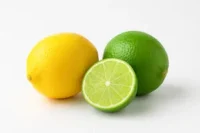Top 15 White Vegetables: Origins, Fun Facts, Taste & Uses
Published: 19 Mar 2025
White vegetables might seem plain but contain nutrients, flavor, and a fascinating history. These vegetables do not stand out visually but play a huge role in a balanced diet. From jicama’s crunchy sweetness to garlic’s heart-protecting power, these veggies are delicious and nutritious!
What Are White Vegetables?
White vegetables are an important part of a balanced diet, providing essential nutrients despite their pale color. Unlike bright-colored vegetables like carrots or spinach, which get their vibrant hues from pigments like beta-carotene and chlorophyll, white vegetables often contain beneficial compounds like flavonoids, allicin, and anthoxanthins.
These natural compounds offer various health benefits, making white vegetables an excellent addition to daily meals. Some white vegetables, like cauliflower and broccoli, belong to the category of flower vegetables, which are known for their rich nutrient content and versatility in cooking.
Nutritional Significance of White Vegetables
Many people assume that colorful vegetables are the only nutritious option, but white vegetables are just as important. They provide:
- Essential Vitamins & Minerals: White vegetables contain vitamin C, potassium, fiber, and calcium, which help in immunity, digestion, and bone health.
- Powerful Antioxidants: Allicin (found in garlic and onions) have antibacterial and antiviral properties, supporting overall health.
- Digestive Health Benefits: The fiber content in white vegetables like potatoes, turnips, and cabbage promotes gut health and prevents constipation.
- Heart Health Support: Many white vegetables help lower blood pressure, reduce cholesterol levels, and support cardiovascular health.
- Immune System Boost: Garlic, onions, and cauliflower contain sulfur compounds that help fight infections and inflammation.
Culinary Uses of White Vegetables
White vegetables are incredibly versatile in cooking. They can be eaten raw, cooked, steamed, grilled, or roasted, making them a great addition to various dishes. Some popular ways to use white vegetables include:
- Soups & Stews: White vegetables like onions, garlic, and turnips add depth of flavor to broths and stews.
- Roasted or Grilled: Vegetables like cauliflower, parsnips, and fennel develop a rich, nutty flavor.
- Mashed & Pureed: Potatoes, cauliflower, and turnips make creamy, delicious purees.
- Pickled & Fermented: White cabbage is a key ingredient in fermented foods like sauerkraut and kimchi, which aid digestion.
- Raw in Salads: Crisp vegetables like white radish, jicama, and fennel. They add crunch and freshness to salads.
- Used in Global Cuisines: White vegetables play a role in many traditional dishes worldwide, from garlic-heavy Mediterranean foods to Indian curries with potatoes and cauliflower.
Why White Vegetables Matter for Home Cooks and Gardeners
For Home Cooks
White vegetables are easy to cook and can be included in various meals, whether for health benefits or taste. They are:
- Affordable and widely available.
- Easy to prepare and pair with other ingredients.
- Suitable for different diets, including vegan, gluten-free, and low-carb plans.
For Gardeners
Many white vegetables are easy to grow at home, making them perfect for beginner and experienced gardeners. They:
- It can be cultivated in different climates.
- Requires minimal care and maintenance.
- They are often resistant to pests and diseases.
- Provide fresh, organic produce with better taste and nutrition.
Final Thoughts
White vegetables may not be as visually striking as their colorful counterparts, but they are nutritional powerhouses with unique health benefits and culinary versatility. Whether you’re a home cook looking to experiment with flavors or a gardener seeking easy-to-grow crops, white vegetables are an excellent choice for your diet.
Pros and Cons of White Vegetables
| Pros of white vegetables |
|---|
|
| Cons of White Vegetables |
|---|
|
Why Are White Vegetables Important?
White vegetables may not be as visually striking as their brightly colored counterparts, but they are just as essential for a healthy and balanced diet. They offer a wide range of nutritional benefits, play a significant role in maintaining overall health, and challenge common misconceptions about their lack of nutrients. Let’s explore why white vegetables are an essential part of your meals.
Nutritional Benefits of White Vegetables
White vegetables are packed with vital nutrients that support various body functions. Despite their pale color, they provide essential fiber, antioxidants, vitamins, and minerals that contribute to well-being.
Rich in Dietary Fiber
Fiber is crucial for digestion, weight management, and heart health. Many white vegetables, such as potatoes, turnips, and cauliflower, are excellent sources of fiber, which helps:
- Improve digestion and prevent constipation.
- Promote gut health by supporting beneficial gut bacteria.
- Control blood sugar levels by slowing glucose absorption.
- Keep you full longer, aiding in weight management.
Powerful Antioxidants for Immunity and Health
Antioxidants help fight free radicals in the body, reducing oxidative stress and lowering the risk of chronic diseases. Some of the key antioxidants in white vegetables include:
- Anthoxanthins: Found in cauliflower, onions, and garlic, these flavonoids have anti-inflammatory and heart-protective properties.
- Allicin: Allicin has antibacterial and antiviral properties in garlic and onions that boost the immune system.
- Quercetin: A powerful antioxidant found in onions that supports heart health and reduces inflammation.
Essential Vitamins & Minerals
White vegetables provide a variety of vitamins and minerals necessary for bodily functions:
- Vitamin C helps to strengthen the immunity system. It supports collagen production and improves skin health.
- Potassium helps regulate blood pressure and fluid balance.
- White beans and mushrooms contain magnesium essential for muscle and nerve function.
- White cabbage, fennel, and turnips contain Calcium, which supports bone health and muscle function.
The Role of White Vegetables in a Balanced Diet
A balanced diet includes a variety of food groups, and white vegetables play a key role in providing necessary nutrients. Here’s how they contribute to overall health:
Supporting Heart Health
Many white vegetables, such as garlic and onions, help reduce cholesterol levels and improve heart function. The potassium in potatoes and parsnips helps regulate blood pressure, reducing the risk of heart disease.
Aiding Digestion and Gut Health
The fibre content in white vegetables like cauliflower and mushrooms promotes a healthy gut. These vegetables act as prebiotics, feeding beneficial gut bacteria and improving digestion.
Boosting the Immune System
White vegetables like garlic, onions, and mushrooms contain compounds that help fight infections, reduce inflammation, and strengthen the immune system.
Supporting Weight Management
White vegetables are often low in calories but high in fiber, helping with satiety and preventing overeating. Cauliflower, for instance, is a great low-carb alternative to grains and can be used in rice or pizza crusts.
Providing Versatility in Cooking
White vegetables are incredibly adaptable to various cuisines. They can be eaten raw, roasted, mashed, or stir-fried, making them a staple in many healthy recipes.
Common Misconceptions About White Vegetables
Myth #1: White Vegetables Lack Nutrients
Many believe that only colorful vegetables are nutritious, but this is a misconception. White vegetables contain essential vitamins, minerals, and antioxidants that contribute to overall health.
Myth #2: White Vegetables Are High in Starch and Unhealthy
While some white vegetables, like potatoes, contain starch, they also provide fiber, potassium, and vitamin C. When prepared healthily (baked or boiled instead of fried), they are a nutritious part of a balanced diet.
Myth #3: White Vegetables Have Less Antioxidants Than Colored Vegetables
Although they lack the bright pigments in other vegetables, white vegetables are rich in anthoxanthins, allicin, and other antioxidants that help fight diseases and inflammation.
Final Thoughts
White vegetables are nutritional powerhouses contributing to heart health, digestion, immunity, and well-being. They play an essential role in a balanced diet, offering fiber, antioxidants, and necessary vitamins. Despite common misconceptions, they are just as beneficial as their colorful counterparts.
Including a variety of white vegetables in your diet ensures a well-rounded intake of nutrients, proving that good health comes in all colors—even white.
Top 15 White Vegetables: Origins, Fun Facts, Taste & Uses
Cauliflower

Origin:
Cauliflower is native to the Mediterranean region and has been cultivated for thousands of years. It was first grown in Asia before reaching Europe and beyond.
Fun Fact:
While white cauliflower is the most common, this vegetable comes in vibrant colors like purple, orange, and green, each with unique antioxidant properties.
Taste & Texture:
Cauliflower has a mild, slightly nutty flavor with a firm yet tender texture when cooked. It absorbs seasonings well, making it a versatile vegetable in various dishes.
Uses:
Cauliflower is widely used in low-carb diets in curries, stir-fries, soups, and even rice substitutes. It can be roasted, mashed, or made into cauliflower pizza crust and gluten-free flour.
Garlic

Origin:
Garlic is believed to have originated in Central Asia and has been cultivated for over 5,000 years. It was essential in ancient Egyptian, Greek, and Chinese medicine and cuisine.
Fun Fact:
Garlic contains allicin, a sulfur compound responsible for its strong aroma and powerful health benefits, including antimicrobial and immune-boosting properties.
Taste & Texture:
Fresh garlic has a strong, pungent taste that mellows into a rich, savory sweetness when roasted or cooked. Its texture is firm when raw but softens when cooked.
Uses:
Garlic is used in almost every cuisine worldwide. It enhances the flavor of soups, sauces, meats, and stir-fries. Roasted garlic can be spread like butter, while raw garlic is often used in salad dressings and dips.
White Onion

Origin:
White onions trace their roots back to Asia and the Middle East, where they have been cultivated for thousands of years. They were widely used in ancient Egypt and later spread across Europe and the Americas.
Fun Fact:
Onions are among the most widely consumed vegetables globally in nearly every cuisine. White onions have a slightly milder taste compared to yellow or red onions.
Taste & Texture:
White onions have a crisp texture and a slightly sweet, sharp flavor. Their taste becomes milder when cooked, making them great for various dishes.
Uses:
White onions are perfect for salsas, salads, and sandwiches. They caramelize beautifully when sautéed, making them ideal for soups, stews, and curries.
White Potato
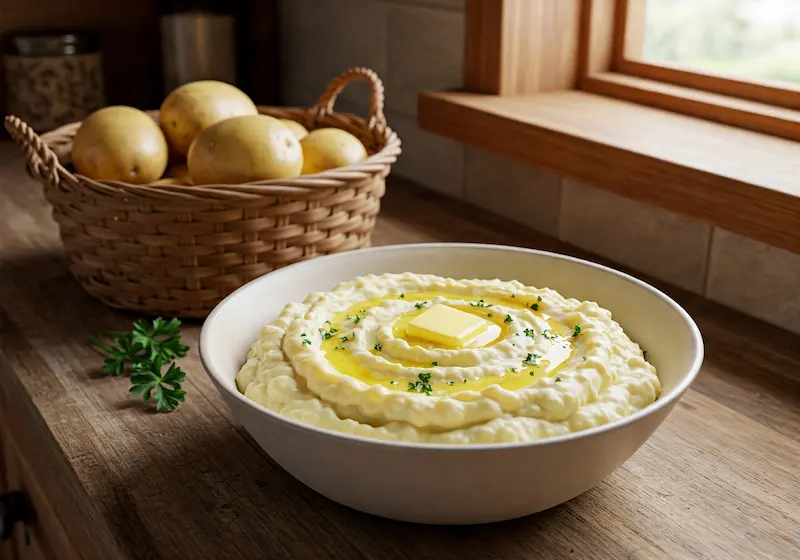
Origin:
Potatoes originated in the Andean region of South America, particularly in modern-day Peru and Bolivia. Spanish explorers introduced them to Europe in the 16th century.
Fun Fact:
Over 4,000 different potato varieties worldwide, ranging in size, shape, and color. White potatoes are among the most commonly consumed.
Taste & Texture:
White potatoes have a starchy, creamy texture with a mild, slightly sweet taste. They are fluffy when mashed and crispy when fried or roasted.
Uses:
Potatoes are a staple ingredient in many cuisines. They are used in mashed potatoes, fries, chips, stews, and even as a thickener for soups and sauces.
Turnip
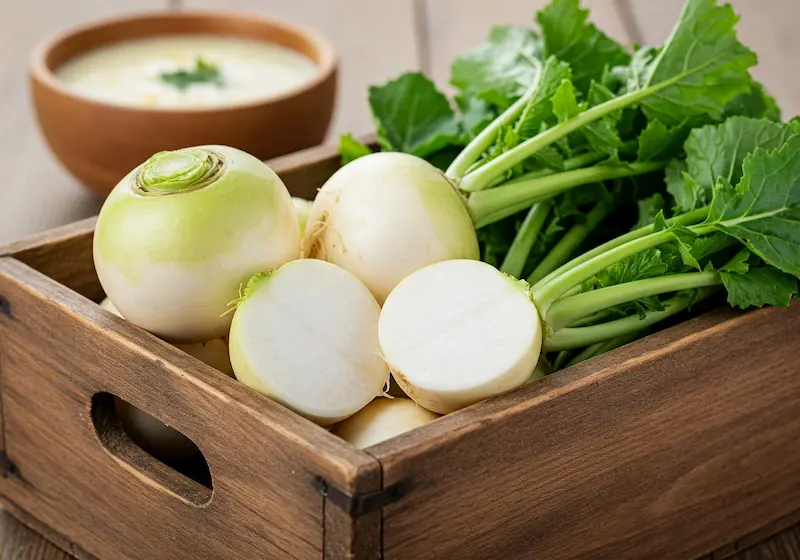
Origin:
Turnips have been cultivated for over 4,000 years in Europe and Central Asia. They were a significant food source in ancient Greece and Rome.
Fun Fact:
Turnips were once considered a “poor man’s food” but are now valued for their health benefits and versatility in cooking.
Taste & Texture:
When raw, turnips have a mildly peppery flavor, which becomes sweeter and softer when cooked. The texture is firm and crunchy, similar to radishes.
Uses:
Turnips can be eaten raw in salads, roasted, boiled, or mashed like potatoes. They are commonly used in soups and stews for their hearty texture.
Parsnip

Origin:
Parsnips originated in the Mediterranean and were a staple food before potatoes became widely available in Europe.
Fun Fact:
Parsnips become sweeter after exposure to frost, making them ideal for late fall and winter harvesting.
Taste & Texture:
Parsnips have a naturally sweet, nutty flavor and a firm texture that softens when cooked. They resemble white carrots but are starchier.
Uses:
Parsnips can be roasted, mashed, or used in soups and stews. They also work well in purees and gratins for a sweet, creamy dish.
White Radish (Daikon)

Origin:
White radish, or Daikon, originated in East Asia and is widely used in Japanese, Chinese, and Korean cuisine.
Fun Fact:
“daikon” means “big root” in Japanese, referring to its long, cylindrical shape.
Taste & Texture:
Daikon has a crisp texture and a mild, slightly spicy flavor when raw. Cooking softens its texture and reduces its spiciness.
Uses:
Daikon is raw in salads, pickled, or cooked in stews and stir-fries. It is also used in kimchi and Japanese miso soup.
Fennel Bulb

Origin:
Fennel is native to the Mediterranean and was highly valued by the ancient Greeks and Romans for its culinary and medicinal properties.
Fun Fact:
Every part of the fennel plant—bulb, stalks, leaves, and seeds—is edible.
Taste & Texture:
Fennel has a crunchy texture with a mild, licorice-like flavor. When cooked, it becomes tender and slightly sweet.
Uses:
Fennel is used in salads, roasted as a side dish, or in soups and sauces.
White Kohlrabi

Origin:
Kohlrabi originated in Europe and is commonly used in German and Indian cuisine.
Fun Fact:
“kohlrabi” means “cabbage turnip” in German, reflecting its taste and appearance.
Taste & Texture:
It has a crisp texture and a mild, sweet flavor, similar to broccoli stems.
Uses:
Kohlrabi is eaten raw in salads, roasted, or stir-fried. It can also be mashed or added to soups.
White Asparagus

Origin:
White asparagus is primarily grown in Europe, especially in Germany, France, and the Netherlands. It is cultivated underground to prevent chlorophyll from developing, keeping it white.
Fun Fact:
White asparagus is considered a delicacy in Europe and has an entire festival dedicated to it in Germany, where it is known as “white gold.”
Taste & Texture:
It has a milder, slightly sweeter taste than green asparagus, with a more delicate, tender texture.
Uses:
White asparagus is commonly steamed, boiled, or roasted and served with hollandaise sauce or butter. It is also used in soups, salads, and pasta dishes.
White Corn

Origin:
White corn originated in Central and South America and was cultivated by the Aztecs and Mayans over 9,000 years ago.
Fun Fact:
White corn is often sweeter and softer than yellow corn, making it a favorite for tortillas and tamales.
Taste & Texture:
White corn has a naturally sweet flavor and a fresh, juicy, crisp texture.
Uses:
It is used in tortillas, grits, cornbread, soups, and salads. White corn can also be grilled, boiled, or roasted for a delicious side dish.
Jicama

Origin:
Jicama is native to Mexico and Central America and has been grown for centuries as a refreshing and nutritious root vegetable.
Fun Fact:
Jicama is sometimes called the “Mexican yam bean” and is 85% water, making it a hydrating snack.
Taste & Texture:
Jicama has a crisp, juicy texture similar to an apple or pear, with a mildly sweet and nutty flavor.
Uses:
Jicama is commonly eaten raw in salads, salsas, or as a crunchy snack with lime and chili powder. It can also be stir-fried or added to soups.
White Cabbage

Origin:
White cabbage has been cultivated for over 3,000 years, originating in Europe before spreading worldwide.
Fun Fact:
Cabbage is one of the oldest known vegetables and was a staple in ancient Roman diets.
Taste & Texture:
It has a firm, crunchy texture when raw and a mild, slightly sweet flavor that softens when cooked.
Uses:
White cabbage is used in coleslaw, stir-fries, soups, and sauerkraut. It can be sautéed, boiled, or fermented for probiotic benefits.
Celery Root (Celeriac)
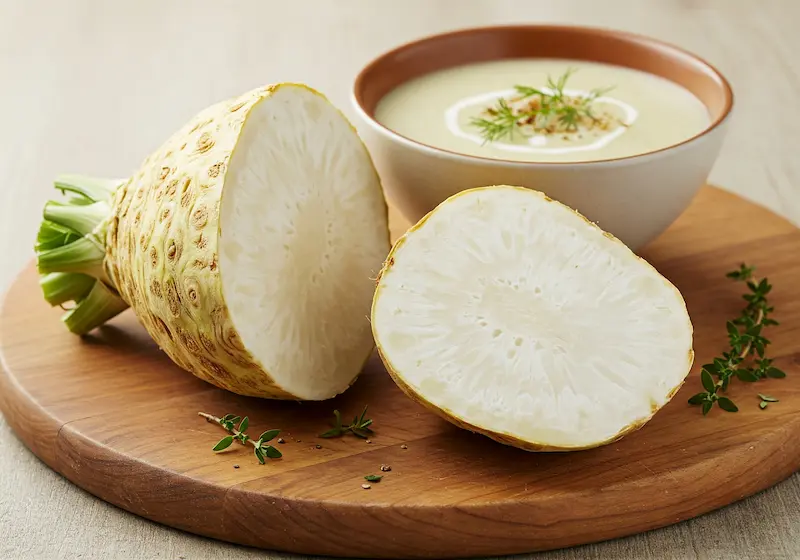
Origin:
Celeriac is native to the Mediterranean and has been cultivated since ancient Greek and Roman times.
Fun Fact:
Although it looks rough and knobby, celeriac has a surprisingly smooth texture when peeled and cooked.
Taste & Texture:
It has an earthy, slightly nutty flavor, similar to celery,y but with a hint of sweetness. The texture is firm when raw and creamy when cooked.
Uses:
Celeriac can be eaten raw in salads, mashed like potatoes, or roasted for a rich, caramelized flavor. It is also used in soups and purees.
White Mushrooms
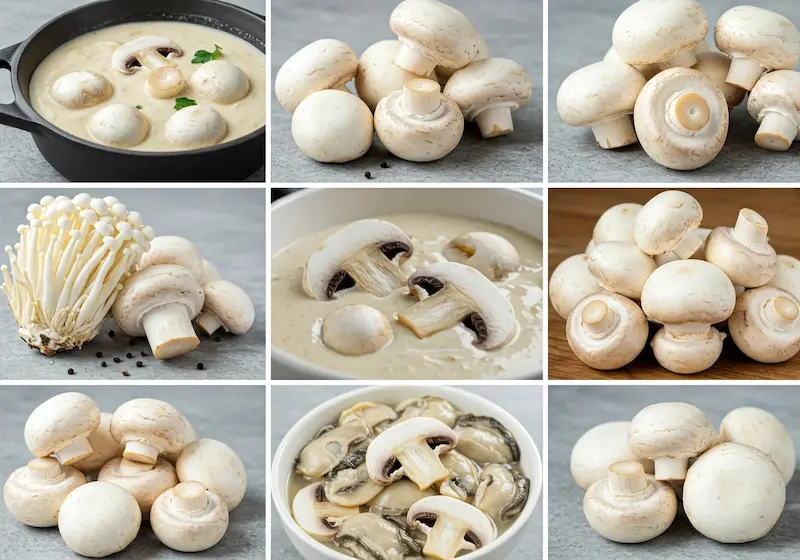
Origin:
White button mushrooms were first cultivated in France in the 17th century and are now one of the most popular worldwide.
Fun Fact:
Mushrooms are not technically vegetables but fungi, yet they are considered vegetables in culinary use.
Taste & Texture:
White button mushrooms have a mild, slightly earthy flavor and a firm, spongy texture that softens when cooked.
Uses:
They are used in soups, salads, pasta, stir-fries, and pizza toppings. Mushrooms can be eaten raw or sautéed for a more prosperous, umami flavor.
Tips for Cooking & Storing White Vegetables
White vegetables are incredibly versatile in the kitchen, but proper cooking and storage techniques are essential to maximize their flavor and nutrients. Below are some expert tips on preserving their freshness, maintaining their nutritional value, and enhancing their taste through different cooking methods.
Best Ways to Preserve Nutrients in White Vegetables
White vegetables, like cauliflower, garlic, and onions, contain essential nutrients such as fiber, antioxidants, and vitamins like C and B-complex. However, improper cooking or storage can cause nutrient loss. Here’s how to retain their goodness:
Gentle Cooking Methods:
Steaming, roasting, and sautéing help preserve vitamins better than boiling, which can lead to nutrient loss in the water.
Cook with the Skin On:
When cooked with their skin, vegetables like potatoes, parsnips, and turnips retain more fiber and nutrients.
Avoid Overcooking:
Overcooking can break down vitamins and antioxidants, making the vegetables less nutritious. Cook them until they are just tender.
Use Minimal Water:
If boiling is necessary, use as little water as possible and consider using the leftover water in soups or sauces to retain nutrients.
Consume Fresh:
The longer vegetables are stored, the more nutrients they lose. Try to eat them fresh for maximum benefits.
Storage Tips for Longer Shelf Life
Proper storage helps prevent white vegetables from spoiling quickly and preserves their texture and taste. Here’s how to store them effectively:
Refrigeration Tips:
Cauliflower & Cabbage: Keep them in a perforated plastic bag in the fridge. Avoid washing before storage to prevent mold growth.
Garlic & Onions: Store in a cool, dry, dark place (not the refrigerator) to prevent sprouting and moisture buildup.
Potatoes & Turnips: Store in a dark, well-ventilated area at room temperature to prevent sprouting and greening. Avoid refrigerating potatoes, as it changes their texture and taste.
Parsnips & Radishes: Keep them in a plastic bag in the crisper drawer of your fridge.
White Corn: Best stored in the husk in the refrigerator and used within a few days for maximum sweetness.
Freezing Tips:
Blanch Before Freezing: Vegetables like cauliflower, white asparagus, and parsnips should be blanched (briefly boiled and then cooled in ice water) before freezing to preserve their texture and nutrients.
Use Airtight Containers: Store chopped vegetables in airtight freezer bags to prevent freezer burn.
Label & Date: Always label the containers with the freezing date to track freshness. Most vegetables last up to 6–12 months in the freezer.
Best Cooking Methods to Enhance Flavor
Cooking white vegetables correctly can bring out their natural flavors and make them more enjoyable. Here are the best methods to use:
Roasting:
It is best for cauliflower, potatoes, parsnips, fennel, and white eggplant. Roasting caramelizes natural sugars in vegetables, enhancing sweetness and creating a crispy texture.
➡️ Tip: Toss the vegetables in olive oil, salt, and herbs before roasting at 400°F (200°C) for 20–40 minutes.
Sautéing:
It is best for garlic, onions, fennel, turnips, and white cabbage. This method adds a rich, golden-brown color while preserving crunch and flavor.
➡️ Tip: Cook vegetables over medium heat in a bit of butter or olive oil, stirring occasionally for even browning.
Steaming:
It is best for white asparagus, white radish (daikon), parsnips, and potatoes. Steaming helps retain nutrients and keeps vegetables moist without using excess oil.
➡️ Tip: Steam for 5–10 minutes until tender, then season with herbs and lemon juice for extra flavor.
Grilling:
It is best for white corn, white eggplant, and fennel bulbs. Grilling adds a smoky, slightly charred taste that enhances natural sweetness.
➡️ Tip: Brush with olive oil, season with salt, and grill over medium-high heat for 3–5 minutes per side.
Pickling & Fermenting:
It is best for white radish, turnips, and cabbage. Pickling and fermenting create a tangy, probiotic-rich food that lasts for months.
➡️ Tip: Submerge sliced vegetables in vinegar or salt brine and let them ferment for extra flavor for a few days to weeks.
Final Thoughts
White vegetables are not only nutritious but also highly versatile when cooked the right way. You can extend their shelf life by using proper storage techniques and choosing the correct cooking methods to enhance their natural flavors. Whether roasting cauliflower, steaming asparagus, or grilling white corn, these tips will help you get the most out of your white vegetables.
Faqs about White Vegetables
- Vegetables are rich in vitamins, minerals, and fiber.
- Eating a variety of vegetables can reduce the risk of chronic diseases.
- Carrots were originally purple, not orange.
- Tomatoes are botanically fruits but are classified as vegetables.
- Potatoes were the first vegetable grown in space by NASA.
- Garlic has natural antibacterial and antiviral properties.
- Spinach loses some nutrients when cooked, but it increases in iron absorption.
- Broccoli contains more protein per calorie than beef.
- Mushrooms are the only vegetable that naturally produces vitamin D.
- Bell peppers come in multiple colors, each with a unique nutrient profile.
- Carrot
- Tomato
- Potato
- Onion
- Garlic
- Cauliflower
- Cabbage
- Spinach
- Broccoli
- Radish
- Turnip
- Lettuce
- Peas
- Pumpkin
- Cucumber
White vegetables are often referred to as pale vegetables or white-fleshed vegetables. Some common ones include:
- Allium vegetables (Garlic, Onion, Leeks)
- Cruciferous vegetables (Cauliflower, Kohlrabi)
- Root vegetables (Potatoes, Turnips, Parsnips, Radishes)
Mushrooms, which are fungi but often grouped with vegetables
Conclusion
White vegetables may not always be the most colorful, but they are packed with essential nutrients, fiber, and antioxidants that support overall health. These vegetables offer unique flavors, textures, and culinary uses, from cauliflower and garlic to turnips and white asparagus. Whether roasted, sautéed, steamed, or pickled, each adds something special to meals while boosting nutrition.
“Have insights on vegetables? We’d love to hear from you! Visit our Write for Us page to submit your article.”

- Be Respectful
- Stay Relevant
- Stay Positive
- True Feedback
- Encourage Discussion
- Avoid Spamming
- No Fake News
- Don't Copy-Paste
- No Personal Attacks



- Be Respectful
- Stay Relevant
- Stay Positive
- True Feedback
- Encourage Discussion
- Avoid Spamming
- No Fake News
- Don't Copy-Paste
- No Personal Attacks



